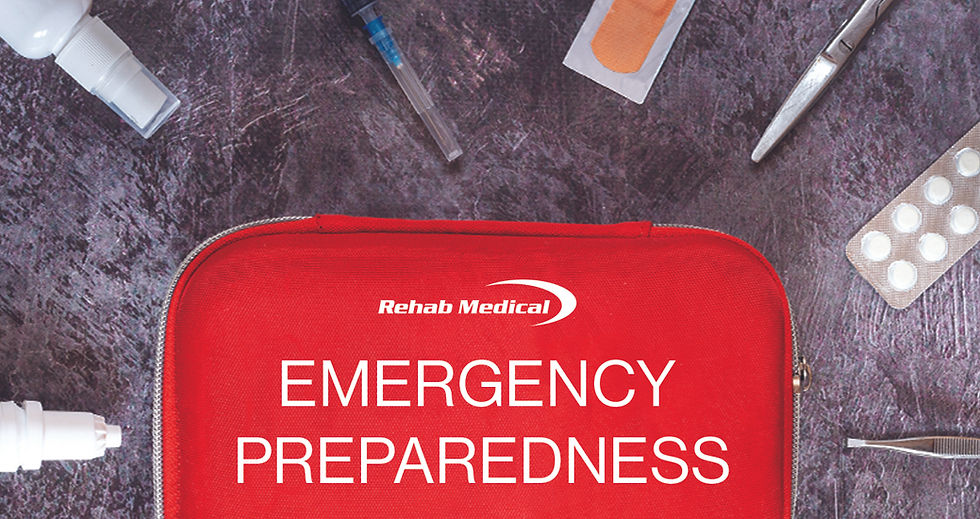A Florida Mobility User’s Guide to Navigating Hurricanes
- Rehab Medical

- Aug 29, 2023
- 4 min read

Hurricane season is upon us and for the mobility users we serve in states like Florida, Texas, Georgia, and Louisiana, the Rehab Medical team has put together a helpful guide to help you safely navigate the season.
As you may already know Atlantic hurricane season typically runs from the first of June to the end of November, but the vast majority of hurricanes make landfall in the U.S. between August and September, that’s six months out of the year of unexpected hurricane activity so being prepared at all times is imperative to the health and safety of you and your loves ones.
The Importance of Preparedness
When you think of hurricanes or tropical storms, states like California probably don’t come to mind but if you’ve been following the news, California has experienced a never before climate anomaly with Hurricane Hillary making landfall first in Mexico then moving its way up through California. Although California is not usually associated with hurricanes, the case of Hurricane Hilary speaks to the uncertainty of weather patterns and the importance of always being prepared. For those living in Florida, hurricane preparedness is crucial in the health and safety of you and your loved ones.
Hurricane and Tropical Storm Preparedness
To date, Florida has been home to more than 100 hurricanes ranging from all category types. And it was recently announced that hurricane Idalia, a category three hurricane, will make landfall in the coming days at more than 110 miles per hour. Track Idalia’s progress here
Whether you are a new or existing Florida resident, staying up to date on trends and preparedness plans is essential. Governor Ron DeSantis, Executive Director Kevin Guthrie, and the Florida Division of Emergency Management (FDEM) have put together a brief guide to hurricane season in 2023.

The guide includes valuable tips such as how to plan for this year’s hurricanes stating that residents should store supplies like food, water, medicine, batteries, etc. for at least seven days. Additionally, you should complete a personal assessment outlining what your personal needs are and what resources you’ll use to meet those needs. This can be in as simple a form of a pros and cons list style.
Another key component of navigating Florida storms is knowing what zone you reside in. You can visit www.FloridaDisaster.org/Know to learn more about your evacuation zone in case evacuation becomes a necessity.
If evacuation is not an option, there are some helpful updates you can make to your home, so it withstands strong storms. FDEM recommends creating a home resiliency checklist which focuses on reducing the amount of wind that can enter your home.

How to Know if Evacuation is Necessary
Leaving your home can be a tough decision to make, especially if leaving it is particularly challenging. So how do you determine if you should leave or stay? First consider the severity of the situation then evaluate your mobility capabilities. If it’s feasible to leave, then create an evacuation plan and act on it asap. But if you are someone who has mobility limitations or are a caretaker of someone with limited mobility, evacuation may be more challenging. However, there are resources you can use tailored to evacuating those with special needs. Visit FloridaDisaster.org/SNR and register for special assistance during an emergency.
Other Emergency Preparedness Tips
For residents who may not reside in either of the more prone hurricane and tropical storm states, anomalies like California can still happen so it’s important to have a general list of emergency supplies should any weather uncertainties occur.
Always keep a stash of non-perishable food and fresh water
Make sure to have some sort of communication device to keep in touch with friends and family and stay in the know
Keeping a waterproof container with important documents such as ID, medical information, insurance, etc. is critical in case you are unable to communicate this information Flashlights, matches, multipurpose tools, and other safety tools are also important to store
A ‘go bag’ is also imperative to have to store items such as clothes, blankets, medications, and protective gear
Familiarize yourself with evacuation plans in your community
If you are able to operate a non-motorized mobility solution, consider keeping one has a backup in case you don’t have access to a charger
Choose a contact outside the state whom you can communicate and check in with
Establish a pre-decided meeting point for your family and a designated place to stay
Recovering from a Hurricane
There are three main things you should do after a hurricane has passed:
Remain inside until the storm has completely passed
Be aware of any power outages
Stay away from flood waters
That last item is probably the most crucial thing to remember because flood waters could potentially hide other hazardous things such as hidden electrical hazards, chemical leaks, displaced wild animals, hazardous debris, and other things.
Staying Informed of Future Hurricanes
Remaining informed during a hazardous storm is crucial because it offers a clear path to safety. The Federal Emergency Management Agency offers multiple resources to keep you informed on hazardous storms by visiting their website at DisasterAssistance.Gov, downloading the FEMA mobile app, or calling them at 800-621-FEMA (3362). You can also take advantage of their temporary disaster recovery centers located all over the country. Be sure to bring your identification cards, insurance information, and a brief description of the damages incurred so they can assist you accordingly.
In conclusion, the journey through hurricane preparedness reveals the critical importance of being proactive, informed, and equipped to face the challenges that these formidable weather events can bring.
Follow us on social media or subscribe to our blog for more health and safety tips!




Comments